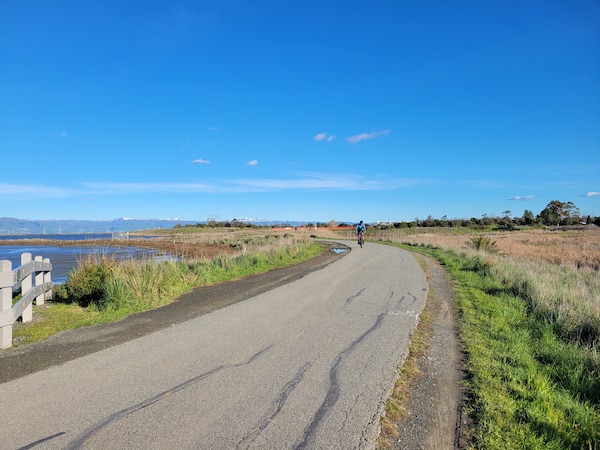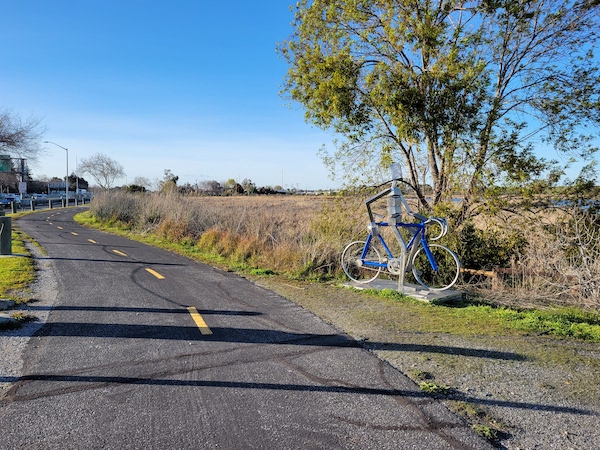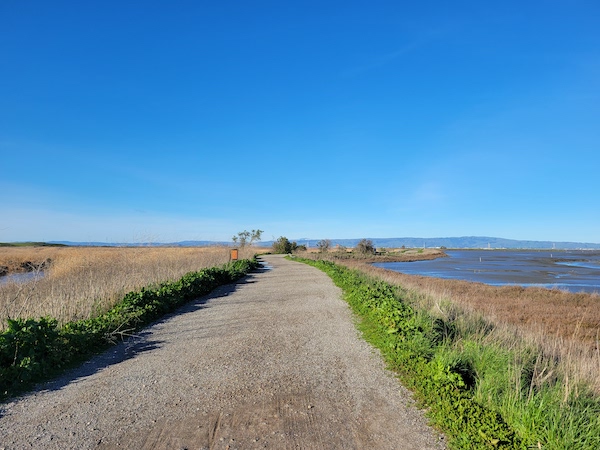I am grateful that Palo Alto’s City Council decided not to allow e-bikes on unpaved trails in our two nature preserves, the Baylands Nature Preserve and the Pearson-Arastradero Preserve. We have beautiful paved trails on the periphery of the Baylands and elsewhere that are perfect for commuting and recreational rides. There is no need to open up trails in more sensitive areas within the preserves. E-bikes are designed to enable more people to bike farther and faster, while nature preserves are meant for low impact human visitation. The Council’s ruling to limit e-bike access is consistent with the Midpen decision on e-bikes in their preserves, which allows e-bikes only on a commute route at the edge of the Ravenswood Preserve and in the high traffic area between the preserve entrance and the farm at Rancho San Antonio.

A paved trail runs along the edge of the Baylands Nature Preserve in Palo Alto
Input from Palo Altans aligned with the decision as well. The Council got considerable feedback in writing and in person from nature lovers, bicycle advocates, and environmental groups. Councilmember Ed Lauing said that around 80% of the feedback requested Council to restrict e-bikes to paved trails. Three large wildlife organizations weighed in with that same perspective.
So the decision seems correct and straightforward. But the discussion leading up to it was anything but.
Several Councilmembers did their homework. Both Pat Burt and Vicki Veenker visited the preserves to better reflect on the policy options in context. Burt went to Arastradero and came away concerned that even the standard bicycle and horse regulations we have in place today may be inadequate on the narrower trails. Veenker went to the Baylands where she was impressed with the serenity and beauty of the place. She came away feeling that e-bikes would unnecessarily intrude. Councilmember Ed Lauing read the full Council packet in detail, referenced many parts of it, and had a thoughtful and well-founded explanation for his stance. Mayor Lydia Kou advocated for the preserves and their inhabitants. She pointed out that our preserves are special places with a charter to protect and prioritize wildlife. Palo Alto has a long history of environmental stewardship and these preserves have taken a concerted effort to establish and protect.

A biker in the Baylands Nature Preserve startles an egret that was hunting by the path
Burt’s observation that regular bikes (and horses) already pose a problem led to some discussion. He asserted that the existing speed limit of 15 mph is not well communicated and added that it is too high to begin with. He suggested 10 mph and proposed asking City staff to consider making this change and improving signage. Moreover, he suggested the city consider banning bikes (and horses) entirely from some of the narrower or more sensitive trails in the preserves. I heard similar concerns during the Midpen discussion, in which people noted that some preserves (e.g., El Corte de Madero in Redwood City and Rancho San Vicente in San Jose) have become so overrun by bikes that they have become unpleasant for people to walk in, at times seeming more like an outdoor adventure park than a nature preserve.
Councilmembers Julia Lythcott-Haines and Greg Tanaka doubled down on Burt’s observation, stating that since regular bikes and even horses are a problem, it makes more sense to regulate the behavior than the technology. If all trail users were limited to 10 mph, would e-bikes be such a concern? But others pushed back, saying that it is not realistic to rely on enforcement and/or good behavior. Our city doesn’t have enough bandwidth to micromanage trail conduct.

Palo Alto’s paved bike trail connects to Shoreline Park in Mountain View
To my surprise, Tanaka, a cyclist, went on to assert that there is no paved trail extending the length of the Palo Alto section of the Bay, though it has been there for ages. He spent several minutes displaying a map, gesturing at “unpaved” sections, and delineating a 10-mile detour that he said was needed in order to get through Palo Alto to Mountain View. This was not helpful, and it concerned me that Tanaka would make such a claim. Fortunately, City staff set the record straight.
Council was slowly converging on a decision to allow e-bikes only on paved trails. A proposal was drafted to add more e-bike parking at the preserve entrances. But then the discussion took a significant detour.
Councilmember Burt worried that the ban might disadvantage some groups of people, in particular people with disabilities and seniors who might not be able to use a regular bike. Although Palo Alto’s Parks and Recreation Commission worked with several groups as they were formulating this policy, Burt said they should also have consulted with the city’s Human Relations Commission. He proposed that the city set up a streamlined approval process for people with disabilities and seniors so that they can ride e-bikes wherever bikes are allowed in our preserves.
The city’s lawyer pushed back, saying we already streamline a waiver for people with disabilities, as required by law, and there’s not more we can do on that front. A waiver for seniors does not exist, and creating one would carve a gaping hole in the proposed policy. City Manager Ed Shikada said such a process would be a lot of work for staff. He encouraged Council to come to a clearer decision that would require less of city employees.

Cycle-themed artwork decorates Palo Alto’s paved bike trail by the Baylands Nature Preserve
Lythcott-Haines then riffed on Burt’s argument, agreeing with the spirit but arguing that the issue is less one of age than of fitness. She said it’s not seniors so much that would be disadvantaged by a ban on e-bikes, but people of any age who lack fitness. She gave an example of a group of friends who go out for a bike ride in one of our preserves. When they see the “no e-bike” sign, the less fit one with the e-bike is forced to leave the group. Lythcott-Haines added that it can be hard for people to admit they aren’t fit, and an e-bike ban could reveal that to the cyclist's friends. A commenter argued separately that parents who have to carry young children would be disadvantaged if we do not allow e-bikes on unpaved trails, since they might need an e-bike to travel with their load.
These arguments disturbed me. Are people-who-can-ebike-but-not-bike or parents-who-carry-young-children a protected class? And even if they were, does that mean they must have access to every part of a nature preserve? And what exactly is the scope of the city’s Human Relations Commission?

An unpaved road in Palo Alto’s Baylands Nature Preserve
Then there was the argument that e-bikes should be allowed on unpaved roads. If they are able to support trucks, the reasoning goes, then why not e-bikes? Some added a qualifier, saying only wide roads would do, and there was a discussion about whether that was 12 feet or 15 feet. But a sufficiently wide road should be allowed to have bikes on it since the road easily supports much heavier vehicles. Again, this argument made no sense to me. No mention was made about who is driving any trucks on the road, at what speed, or how often, or why that road exists in the first place. The mere presence of a road does not indicate it should be open 24x7 to other vehicles. Moreover, it’s not just vehicle miles traveled that matters, it’s vehicle behavior. E-bikes could go faster, they could go in the rain and dig ruts, they could create spur trails and infringe on habitat. Bikes already do these things. Do we want more of that?
E-bikes are great transportation options, they are a lot of fun to ride, and they help to get people out of cars. But that doesn't mean we should allow them to go everywhere. Our preserves are precious places, and pressure on them is increasing. We all want to get out more, exercise, and enjoy nature. It is restorative, for us. But preserves are intended to nourish and protect wildlife. With habitat shrinking because of development and climate change, we must protect and even expand our preserves. We should balance our needs and desires for access with those of the preserves’ inhabitants. Maybe then the nature we love will be around longer for us to enjoy.
Notes and References
1. This discussion is happening all over. The Washington Post had an interesting op-ed on the topic a few days ago. The author talked with a cyclist about doing a long-distance ride in the Washington trail system. “On a regular bike, the ride takes him half a day. On his e-bike, he can knock it out in a few hours. 'I e-bike to get away from the crowds' on the trail, he told me. And the more we’re getting away from each other, the more we inevitably disturb wildlife.”
Current Climate Data (January 2023)
Global impacts, US impacts, CO2 metric, Climate dashboard
Comment Guidelines
I hope that your contributions will be an important part of this blog. To keep the discussion productive, please adhere to these guidelines or your comment may be edited or removed.
- Avoid disrespectful, disparaging, snide, angry, or ad hominem comments.
- Stay fact-based and refer to reputable sources.
- Stay on topic.
- In general, maintain this as a welcoming space for all readers.



